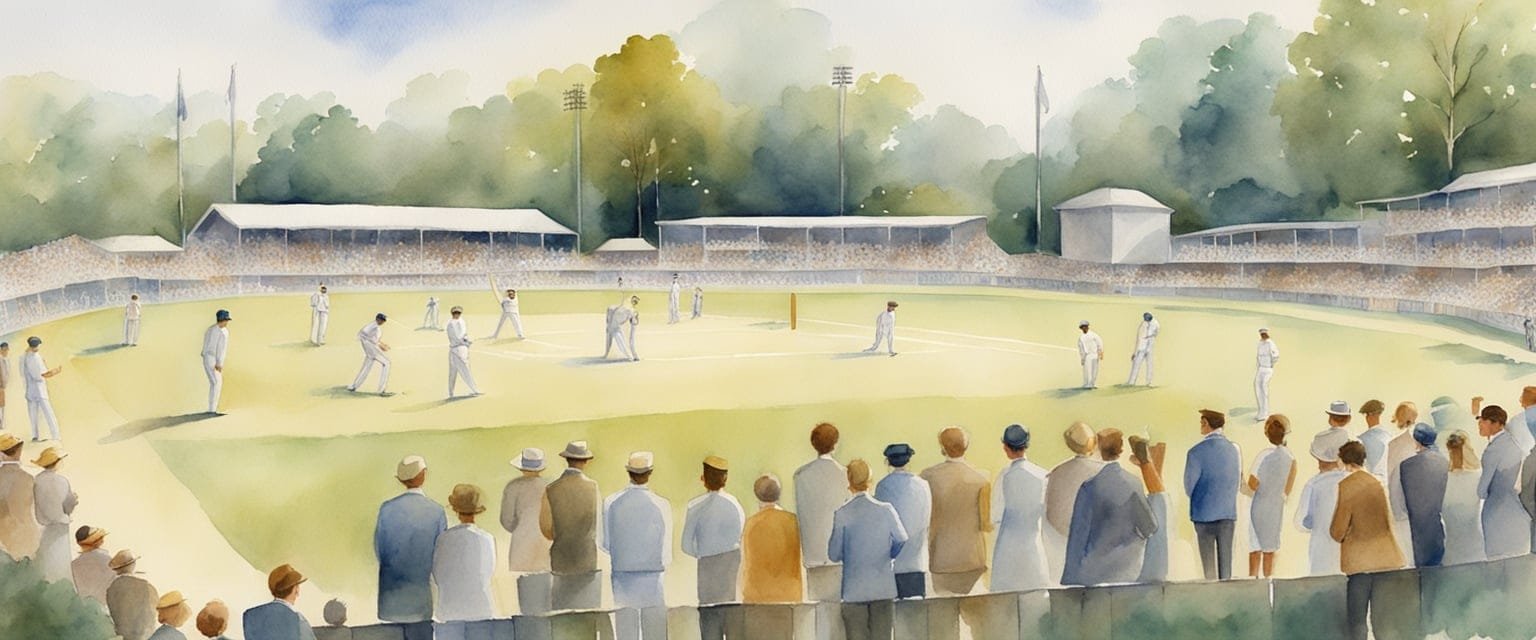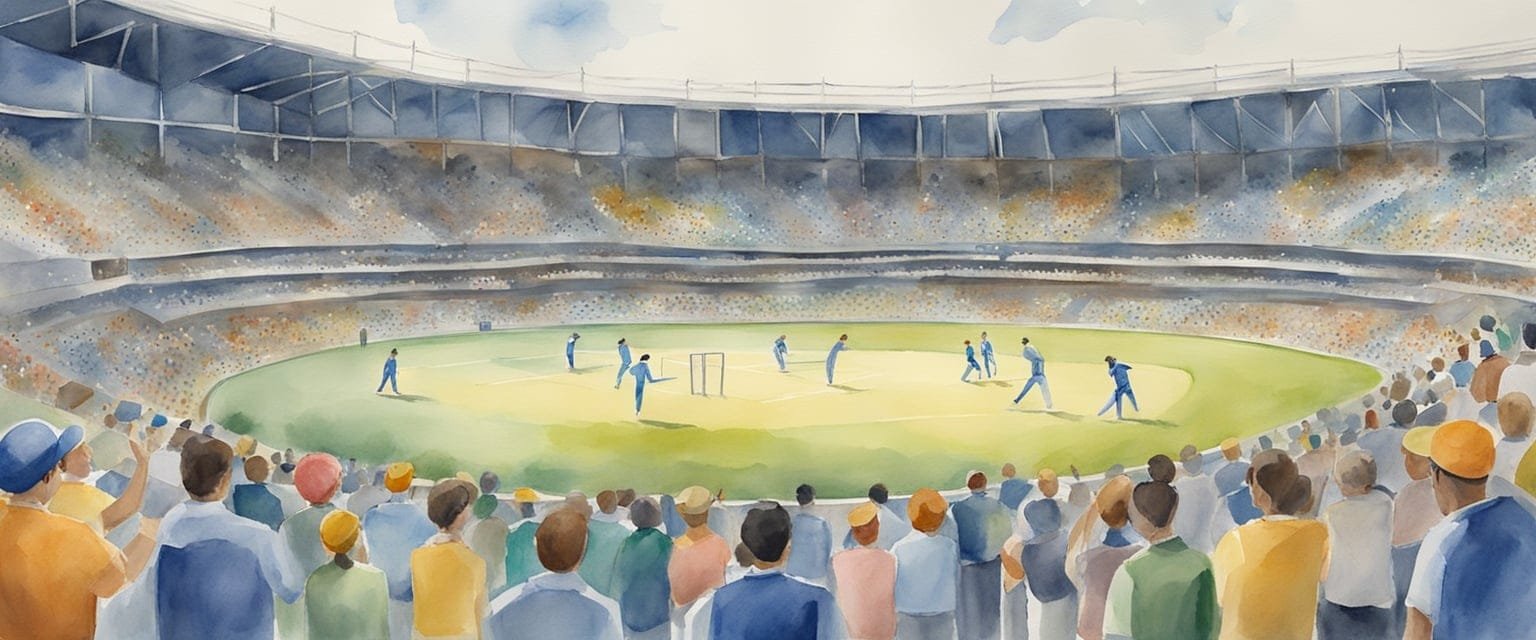Cricket is making a significant return to the Olympic Games, and I couldn’t be more excited! The addition of Olympic cricket, starting from the Los Angeles 2028 Games, offers an incredible opportunity for fans and players to engage with this beloved sport on a global stage. As someone who loves cricket, I know this is a momentous occasion that can elevate the game to new heights and attract new fans.

In this ultimate guide to Olympic cricket, I will explore the history of cricket in the Olympics, the different formats of the game, and how teams will qualify for this prestigious event. I’ll also dive into the players to watch and what impact this return may have on the sport’s legacy. Whether you’re a seasoned fan or just curious about the game, there’s something here for everyone.
Let’s get ready to dive into the world of Olympic cricket and uncover what makes it so special and exciting!
Key Takeaways
- Olympic cricket will return at the Los Angeles 2028 Games.
- Understanding the various formats of cricket is essential for fans.
- The legacy of Olympic cricket could reshape the sport’s future.
The History of Cricket in the Olympics
Cricket has had an interesting journey in the Olympics, from its early beginnings to efforts for revival in modern times. I’ll explore some key moments in this history, highlighting significant events and future prospects.
Early Years and Discontinuation
Cricket made its Olympic debut during the Paris 1900 games. Only two teams participated: Great Britain, represented by the Devon and Somerset Wanderers, and France. This match was unique, as it included English expatriates playing for the French team. The event received little attention and was never held again after that.
In the following decades, cricket was not part of the Olympics. There were attempts to include it again, but the lack of global interest and organization made it challenging. The 1920, 1932, 1968, and 1980 games all passed without cricket in the lineup, as the sport struggled to gain broader recognition.
Revival Efforts and Modern Developments
Interest in bringing cricket back to the Olympics began to grow in the late 20th century. By 2008, the International Olympic Committee started exploring options for different sports. Cricket was part of discussions, especially after the popularity of limited overs formats like One Day Internationals (ODIs) and Twenty20.
These formats made cricket more viewer-friendly and appealing to younger audiences. This led to more serious proposals to include cricket in the Olympic program again. However, discussions remained ongoing with no final decision.
Cricket’s Path to LA28
With cricket gaining momentum, the focus now shifts to the 2028 Los Angeles Olympics (LA28). The possibility of introducing a Twenty20 format seems promising, as it aligns with the fast-paced nature of Olympic competitions. Many see this as a chance to attract a new generation of fans.
In recent years, international interest has surged, making it a relevant sport for the Olympics. As anticipation builds for LA28, I look forward to seeing how the cricket community rallies to make this dream a reality.
Understanding Cricket: The Sport and Its Variants

Cricket is a fascinating bat-and-ball sport with several formats that appeal to different audiences. I find it interesting to explore the basic rules and gameplay, as well as the exciting T20 format, which has rapidly gained popularity.
Basic Rules and Gameplay
In cricket, two teams compete against each other. Each team has eleven players, with roles split between batters and bowlers. The game starts with a bowler delivering the ball to a batter, who aims to score runs.
Runs can be scored by running between two sets of posts called wickets or by hitting the ball to the boundary. Each team has a turn to bat and a turn to bowl. A standard game consists of several overs, with six balls bowled per over.
The laws of cricket dictate gameplay, such as how runs are scored and how wickets can be taken. When a batter is out, they must leave the field, and the next player comes in to bat. A match can be played in various formats, including Test cricket, which lasts up to five days, or limited-overs formats, where each team bats for a set number of overs.
T20 Cricket Explained
T20 cricket, part of the Twenty20 format, has revolutionized the sport. Each team bats for just 20 overs, making matches last about three hours. This fast-paced style means every moment is exciting!
In T20, I love how teams need to be strategic, balancing aggressive batting with solid bowling. This format emphasizes high scores, so players aim to hit boundaries and take risks.
The T20 World Cup showcases the best teams globally, and I enjoy the thrill of watching countries compete in this short yet intense format. Due to its popularity, T20 has drawn new fans and has been included in discussions for the Olympics, highlighting its growing importance in the cricket world.
Cricket at the Olympics: The Vision

Cricket’s inclusion in the Olympics marks a significant milestone for the sport. I see this as a chance to blend the amateur spirit of cricket with the professional excellence associated with the Olympic Games.
Amateur Spirit and Professional Excellence
The Olympic movement values fair play and the spirit of sport. I believe cricket can exemplify these ideals, as it has a rich history roots in community and camaraderie.
Players represent their nations, showcasing not just their skills but also their passion. This combination of national pride and sportsmanship aligns perfectly with what the Olympics stand for.
On the professional side, competing for an Olympic gold medal is a prestigious goal for cricketers. This motivates teams to elevate their performance while sharing the joy of cricket with fans worldwide.
By uniting amateur values with professional competition, cricket can flourish in the Olympic arena.
Tournaments and Competitions Preceding the Olympics

Before the Olympic cricket event, several important tournaments and competitions shape the landscape of international cricket. These events not only serve as qualifiers but also help teams prepare for the intensity of the Olympics. I’ll explore key competitions, their significance, and the role of the International Cricket Council (ICC).
World Cup and World T20
The ICC Cricket World Cup is one of the most prestigious tournaments in the sport. Held every four years, it gathers the best national teams to compete for the title of world champion. The next World Cup will take place in India in 2023.
Additionally, the ICC T20 World Cup showcases the shorter format of the game, attracting a wide audience. This fast-paced tournament also supports countries striving for Olympic qualification. By performing well in these events, teams can boost their confidence and improve their rankings, which is crucial when preparing for the Olympics.
International Cricket Council & Its Role
The International Cricket Council (ICC) plays a vital role in organizing cricket tournaments worldwide. It sets the rules and formats for competitions, including the World Cup and T20 events. The ICC also oversees the qualification process for the Olympics, ensuring that the best teams have a chance to compete.
Moreover, the ICC promotes cricket globally, aiming to include more countries in major competitions. This inclusivity allows emerging cricket nations to gain experience and improve their skills. The ICC’s efforts help raise the level of play, which is beneficial for Olympic cricket.
Other International Events
Apart from the World Cup and T20 tournaments, several other international events help teams prepare for the Olympics. The Commonwealth Games and the Asian Games often feature cricket as a sport. These competitions provide a platform for teams to test their strategies and player combinations.
Participating in these events also builds team chemistry and experience. Teams often use these competitions to identify strengths and weaknesses before crucial tournaments like the Olympics. The exposure gained from these international matches is invaluable for all players.
Teams and Players: Stars of the Field

In the world of Olympic cricket, teams and players play a crucial role in shaping the sport. I want to highlight some of the standout cricketers and discuss how international teams showcase their talent on this grand stage.
Notable Olympic Cricketers
When I think of notable cricketers, names like Mithali Raj and Virat Kohli immediately come to mind. Mithali, known for her leadership and skills, has inspired many in the women’s game. Virat, a dynamic player, has set records while maintaining a dedicated fan base.
Other stars include Harmanpreet Kaur, who showcased her talents in T20 formats. Players from countries like Australia and England, along with unsung heroes from teams like the West Indies and Ireland, also have a special place in Olympic cricket.
Men’s and Women’s Cricket Worldwide
Cricket unites nations, and men’s and women’s cricket have grown tremendously worldwide. In places like India, cricket isn’t just a sport; it’s a way of life. The India cricket team has passionate fans that support them through every match.
Meanwhile, women’s cricket has gained momentum. With players like Kaur leading the way, the female representation in cricket is strengthening. Countries like Australia and England are investing in women’s leagues, making the game more competitive and exciting.
Team Dynamics and International Representation
Team dynamics are critical in cricket. Players must collaborate, as success comes from teamwork. The England and Wales Cricket Board, for instance, emphasizes unity among players.
I enjoy watching how teams like India, Australia, and the West Indies train together, blending strategies and styles. Each player contributes, whether a wicketkeeper, bowler, or batsman. This blend of talent forms strong teams that can compete at the Olympic level.
I look forward to seeing how these teams and players will shine in future Olympic events.
The Road to Olympic Qualification

Getting to the Olympic Games in cricket is a thrilling journey. It involves a precise qualification process where teams strive to secure their spots through various events and matches. Here’s how the qualification works.
Qualifying Criteria and the Process
To qualify for the Olympic Games, cricket teams must meet specific criteria. The International Cricket Council (ICC) oversees this process, which includes various tournaments leading up to the Olympics.
The main path for qualification is through regional tournaments, which are often held a few years before the Olympic Games. Teams from different continents compete for limited spots. In addition, the top-ranked teams in the ICC standings can also earn a direct entry.
In total, there are usually six or more teams that qualify for the men’s and women’s events at the Olympics. I always find it exciting to track how different nations perform in these qualifiers leading up to the big event!
Impact and Legacy

Cricket’s inclusion in the Olympics marks a significant shift for the sport. This move not only helps expand cricket’s reach but also reflects the growing global interest in this beloved game. I believe that the Olympics can play a crucial role in enhancing the sport’s profile and fostering new fans.
Elevating Cricket’s Global Footprint
By joining the Olympic movement, cricket is set to reach millions of new viewers. The Olympic Games attract a vast global audience, including many who may not typically watch cricket.
This exposure can introduce cricket to diverse cultures and regions. For instance, areas where cricket is less popular may see greater interest due to the Olympic spirit.
The T20 format of cricket is energetic and can easily capture the attention of casual viewers. With exciting matches and international competition, I think this will help grow cricket’s fan base significantly.
The Influence of Olympic Inclusion
Inclusion in the Olympics offers cricket a unique platform. It allows players to compete for Olympic medals and gain recognition on a global stage.
This can boost the sport’s appeal, especially among young athletes who dream of Olympic glory. I see how this can inspire the next generation to pick up a bat and ball.
Additionally, cricket’s Olympic status could lead to increased investment and sponsorships. Financial backing can help develop infrastructure and grassroots programs, ensuring steady growth.
As cricket grows through the Olympics, I hope to see a blend of long-standing traditions and new innovations that help the sport thrive worldwide.
Looking Towards the Future

The inclusion of cricket in the 2028 Olympics marks an exciting shift for the sport. I see numerous opportunities for innovation and growth, along with the potential for cricket to evolve beyond the LA28 Games.
Innovations and Growth Opportunities
I believe that bringing cricket to the Olympics opens doors for innovative formats. The T20 format is particularly appealing due to its fast-paced nature. This could attract new fans, making the game more exciting.
Additionally, the LA28 organizing committee could introduce technology to enhance viewer engagement. Live stats, player tracking, and virtual experiences might allow fans to connect with the game like never before.
These innovations can boost participation at grassroots levels. By fostering youth leagues and women’s cricket, the sport can grow and gain wider recognition, which is essential for its future.
Beyond 2028: Cricket’s Continual Evolution
After 2028, I expect cricket to continue evolving significantly. The success of cricket in the Olympics might lead to more frequent international events. This includes expanding T20 leagues around the world, which can draw in diverse talent.
I’m particularly excited about the global reach of cricket. Countries with emerging talent, like those from Africa and the Americas, could see increased interest. This results in a richer competition and a wider fan base.
With the focus on inclusivity and diversity, cricket will attract new audiences. Embracing fans from various backgrounds can help the sport thrive in the coming years.
Frequently Asked Questions
I know many people have questions about cricket’s role in the Olympics. This section covers training for players, the rules and scoring systems, historical insights, and more. Let’s dive into the details.
How can cricket players prepare and train for the Olympic games?
To prepare for the Olympics, cricket players focus on specific training routines. They work on skill development, fitness, and teamwork. Regular practices include batting, bowling, and fielding drills. Mental preparation is also key, as players need to handle the pressure of competition.
What are the rules and scoring system of cricket in the Olympics?
In Olympic cricket, the format usually follows the Twenty20 style. Each team bats for 20 overs, with a maximum of 120 balls. Points are scored for runs made, and the team with the most runs wins the match. The rules are similar to other Twenty20 matches.
Which teams have won cricket medals in previous Olympic games?
Cricket has a limited Olympic history, having appeared only once in 1900. At the Paris Games, Great Britain won the gold medal, while France took home silver. Since then, cricket has not been part of the Olympics until its planned return in 2028.
What is the history of cricket as an Olympic sport?
Cricket made its Olympic debut at the 1900 Paris Games. Only two teams participated: Great Britain and France. Despite its rich history, cricket was dropped from the Olympic program after this event. The sport is set for a comeback in the 2028 Olympics.
How is cricket in the Olympics different from traditional cricket matches?
Olympic cricket focuses on limited overs formats, mainly Twenty20. This means shorter matches, which create a fast-paced and exciting atmosphere. Traditional formats like Test cricket are not part of the Olympic competition. The condensed nature of the game makes it more viewer-friendly.
What are the qualification criteria for cricket teams to compete in the Olympics?
Teams must undergo a qualification process to secure a spot. This includes performing well in international tournaments and the rankings set by the International Cricket Council (ICC). The top teams will earn their places in the Olympic competition based on these criteria.

